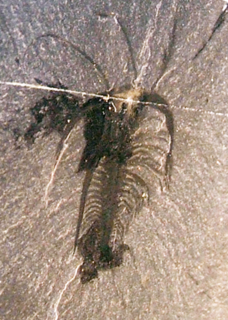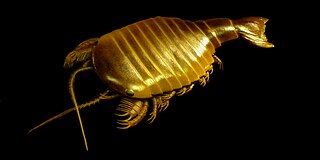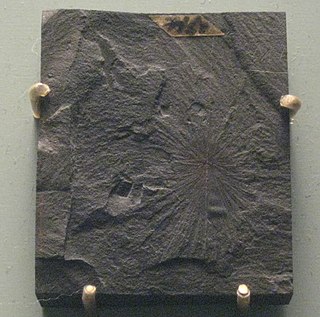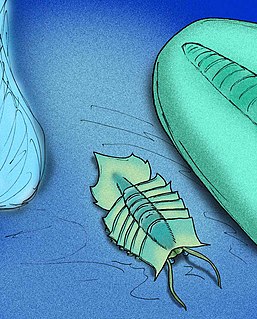
Marrella is an extinct genus of arthropod known from the middle Cambrian Burgess Shale of British Columbia. It is the most common animal represented in the Burgess Shale.

Sidneyia is an extinct arthropod known from fossils found from the Early Cambrian-age Maotianshan Shales to the Mid Cambrian Burgess Shale formation of British Columbia. 144 specimens of Sidneyia are known from the Greater Phyllopod bed, where they comprise 0.27% of the community.

Kootenia is a genus of trilobites of the family Dorypygidae. 118 specimens of Kootenia are known from the Greater Phyllopod bed, where they comprise 0.22% of the community. Its major characteristics are that of the closely related Olenoides, including medium size, a large glabella, and a medium-sized pygidium, but also a lack of the strong interpleural furrows on the pygidium that Olenoides has.

Choia is a genus of extinct demosponge ranging from the Cambrian until the Lower Ordovician periods. Fossils of Choia have been found in the Burgess Shale in British Columbia; the Maotianshan shales of China; the Wheeler Shale in Utah; and the Lower Ordovician Fezouata formation. It was first described in 1920 by Charles Doolittle Walcott.

Elrathia is a genus of ptychopariid trilobite species that lived during the Middle Cambrian of Utah, and possibly British Columbia. E. kingii is one of the most common trilobite fossils in the USA locally found in extremely high concentrations within the Wheeler Formation in the U.S. state of Utah. E. kingii has been considered the most recognizable trilobite. Commercial quarries extract E. kingii in prolific numbers, with just one commercial collector estimating 1.5 million specimens extracted in a 20-year career. 1950 specimens of Elrathia are known from the Greater Phyllopod bed, where they comprise 3.7% of the community.
"...trilobite occupied the exaerobic zone, at the boundary of anoxic and dysoxic bottom waters. E. kingii consistently occur in settings below the oxygen levels required by other contemporaneous epifaunal and infaunal benthic biota and may have derived energy from a food web that existed independently of phototrophic primary productivity. Although other fossil organisms are known to have preferred such environments, E. kingii is the earliest-known inhabitant of them, extending the documented range of the exaerobic ecological strategy into the Cambrian Period."

Helmetia is an extinct genus of arthropod from the middle Cambrian. Its fossils have been found in the Burgess Shale of Canada and the Jince Formation of the Czech Republic.

Chancelloria is a genus of early animals known from the Middle Cambrian Burgess Shale, the Comley limestone, the Wheeler Shale, the Bright Angel Shale and elsewhere. It is named after Chancellor Peak. It was first described in 1920 by Charles Doolittle Walcott, who regarded them as one of the most primitive groups of sponges. This appears unlikely, and it is currently placed in the enigmatic group Coeloscleritophora. 178 specimens of Chancelloria are known from the Greater Phyllopod bed, where they comprise 0.34% of the community.

Plenocaris plena is a crustacean-like arthropod with a bivalved carapace, and is known from the Burgess shale and Chengjiang. 106 specimens of Plenocaris are known from the Greater Phyllopod bed, where they comprise 0.20% of the community.
Morania is a genus of cyanobacterium preserved as carbonaceous films in the Middle Cambrian Burgess Shale. it is present throughout the shale; 2580 specimens of Morania are known from the Greater Phyllopod bed, where they comprise 4.90% of the community. It is filamentous, forms sheets, and resembles the modern cyanobacterium Nostoc. It would have had a role in binding the sediment, and would have been a food source for such organisms as Odontogriphus and Wiwaxia.
The Phyllopod bed, designated by USNM locality number 35k, is the most famous fossil-bearing member of the Burgess shale fossil Lagerstätte. It was quarried by Charles Walcott from 1911–1917, and was the source of 95% of the fossils he collected during this time; tens of thousands of soft-bodied fossils representing over 150 genera have been recovered from the Phyllopod bed alone.
Ehmaniella is a genus of trilobite known from the Middle Cambrian Burgess Shale. 392 specimens of Ehmaniella are known from the Greater Phyllopod bed, where they comprise .74% of the community.

Falospongia is a genus of sponge made up of radiating fronds, known from the Middle Cambrian Burgess Shale. Its name is derived from the Latin fala ("scaffold") and spongia ("sponge"), referring to the open framework of the skeleton. It superficially resembles Haplistion but is monaxial. 5 specimens of Falospongia are known from the Greater Phyllopod bed, where they comprise under 0.1% of the community.

Micromitra is a genus of brachiopods known from the Middle Cambrian Burgess Shale. 160 specimens of Micromitra are known from the Greater Phyllopod bed, where they comprise 0.3% of the community.

Pagetia Walcott, 1916. is a small genus of trilobite, assigned to the Eodiscinid family Pagetiidae and which had global distribution during the Middle Cambrian. The genus contains 55 currently recognized species, each with limited spatial and temporal ranges.
Paterina is a genus of brachiopods known from the Middle Cambrian Burgess Shale. 18 specimens of Paterina are known from the Greater Phyllopod bed, where they comprise 0.03% of the community.
Peronochaeta is a genus of annelid known from the Middle Cambrian Burgess Shale. 19 specimens of Peronochaeta are known from the Greater Phyllopod bed, where they comprise < 0.1% of the community. The genus was described by Conway Morris (1979) and re-examined by Eibye-Jacobsen (2004).
Oryctocephalus is a genus of trilobite known from the Middle Cambrian Burgess Shale. 24 specimens of Oryctocephalus are known from the Greater Phyllopod bed, where they comprise 0.42% of the community. This small- to medium-sized trilobite's major characteristics are prominent eye ridges, pleural spines, long genal spines, spines on the pygidium, and notably four furrows connecting pairs of pits on its glabella. Juvenile specimens have been found with only 5 or 6 thoracic segments and about one eighth of adult size, as well as about 2 mm wide.

Selkirkia is a genus of predatory, tubicolous priapulid worms known from the Middle Cambrian Burgess Shale, Ogygopsis Shale and Puncoviscana Formation. 142 specimens of Selkirkia are known from the Greater Phyllopod bed, where they comprise 0.27% of the community. In the Burgess Shale, 20% of the tapering, organic-walled tubes are preserved with the worm inside them, whereas the other 80% are empty. Whilst alive, the tubes were probably vertical, whereas trilobite-occupied tubes are horizontal.
Stephenoscolex is a genus of polychaete worm known from the Middle Cambrian Burgess Shale. 150 specimens of Stephenoscolex are known from the Greater Phyllopod bed, where they comprise 0.29% of the community. The genus was described by Conway Morris (1979) and re-examined by Eibye-Jacobsen (2004).

Diagoniella is a genus of sponge known from the Middle Cambrian Burgess Shale. 128 specimens of Diagoniella are known from the Greater Phyllopod bed, where they comprise 0.24% of the community.













